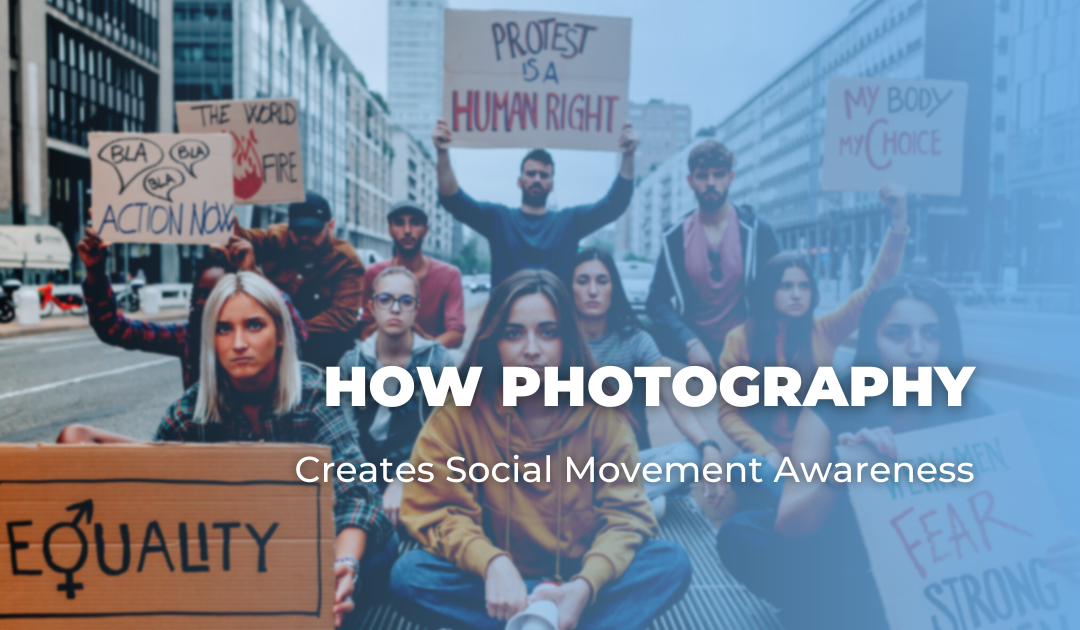
As all photographers—trained or self-taught—come to learn, a good picture tells a story. The story that a picture tells is always in the eye of the beholder, but a skilled photographer uses what they know to give an image a purpose. In social movements, the purpose of a photograph is often to communicate a narrative to its audience. This narrative can do many things—evoke strong emotion, inspire passionate acts of activism, generate sympathy for a cause, and so much more.
If a photographer knows how to capture the essence of a struggle in a single image, this image can have ripple effects that are capable of shaping the face of a social movement. This is what we unpack below.
How a Photograph Communicates a Narrative
The power of a photograph lies in its symbolism. Each element of a skillfully framed image is actually a symbol that tells a much deeper story than a viewer may catch at a glance. A single protester captured in sharp focus holding up a picket sign and vocalizing their rage and pain is a symbol for the human spark that ignited the fire. A backdrop of hundreds or thousands of other protesters behind them shows that this depth of emotion is shared by a collective. A line of riot officers standing steadfast, uniform, and immovable in front of a crowd of protestors is a visual analogy for an institution of oppression.
While the symbols communicated by photographs are rarely explicit, they invite the viewer to step into the scene, and in doing so, allow them to briefly comprehend the story behind a movement. The injustice that gave rise to suffering, the experiences of those who mobilize for their families and communities, and the complexity of the struggle taking place.
Realities that had before seemed so far away and so abstract are suddenly in your face, and the story becomes far more relatable. Language, while powerful in its own right, can only do so much to bring alien concepts into stark understanding. Images, however, can communicate a different kind of hard-hitting message in an instant.
Iconic Photography from Contemporary Social Movements
One of the largest social movements of our time is the Black Lives Matter (BLM) movement. BLM supporters take to the streets in droves to combat institutional racism that has plagued the United States, and many other nations, for hundreds of years.
The death of George Floyd at the hands of a Minneapolis police officer added a significant amount of fuel to an already raging fire, which led to people taking to the streets in their thousands to protest police brutality against the African American population.
How has photography contributed to this, one of the most important and widespread social movements of this era?
Some influential photographs include images of scenes of protesting crowds made up of people of all ages, ethnicities, cultures, and backgrounds in cities all over the United States, demonstrating peacefully against systemic racism. These images communicate something that mainstream media doesn’t—the support for BLM isn’t just localized to one region or one social group. The solidarity that the photographs of the George Floyd protests communicate could only have been captured in images.
Not only does this kind of visual communication bolster the morale of protestors, but it also communicates to the African American community at large that they are not alone in their struggle. It tells them that they have allies outside of their own insular communities and that people all over the world are just as outraged and heartbroken as they are.
Capturing human subjects in moments of unified resistance immortalizes a story, the human solidarity behind the story, and the collective emotion behind the solidarity.
Visual Communication Systems and Social Justice
Nowadays, career photographers and photojournalists make it their duty to show the world what is happening beyond their doorsteps. Thanks to their vigilance and decentralized systems of visual communication, it is much harder to keep entire populations in the dark.
Social media, while it certainly has its drawbacks, also allows for the instantaneous dissemination of meaningful images. Photojournalists and amateur photographers have captured heinous acts of injustice on film and shared their images with the world thanks to the networks we have at our fingertips.
The conjunction of communications technology and photography is a big part of how we as a society hold the perpetrators of injustice accountable. It’s hard to hide behind misleading propaganda when there are photographers out there ensuring that the truth is accessible to those willing to see it.
Technical Expertise in Photography
There is far more to capturing a meaningful photograph than simply being in the right place at the right time with a camera and a good idea. Photographers learn how to understand how elements like light, shadow, composition, focus, and framing can capture the elements of a specific story they wish to tell.
What’s more, in the context of social movements, these images often need to be captured within environments of extreme turmoil and unrest. Everything is happening all at once, and the photographer needs to be able to frame it in a way that tells the story.
This kind of artistic and technical expertise generally comes with years of training and experience. And, it’s inarguably one of the most important skills that humanity has to offer.
A Real World View
From the Civil Rights Movement to #MeToo, photography has been there to bring pivotal moments in social justice into stark relief. Without photographs, our collective understanding of social movements would be painfully reduced. You may even go as far as to say that some social movements depended on dedicated and skilled photographers for their success.
As long as we have photographs to tell stories, we know that we will have the privilege of seeing for ourselves what kind of struggles are taking place in the world. We will have greater insight into complex stories that shape different cultures and societies, and we will be able to take a greater part in those stories ourselves.
 Author:
Author:
Sydney Evans is a self proclaimed photophile and a content writer for various online photography outlets. She covers topics ranging from creative compositions, photography techniques, as well as advertising and promotions. In her free time, she carries a camera over her shoulder and takes snaps of subjects she finds fun and have deeper meaning.


Recent Comments